Setting
Stone is a story about a criminal, Ae, who lives in a utopian society, the 't'T', which is spread across a region of space where the density of interstellar objects is sufficiently low that faster-than-light travel is permitted. This society heavily uses nanotechnology, here called 'Dot-tech.' One of the primary uses of Dot-tech is to maintain peoples' health and safety, enabling citizens of the t'T to survive in extreme conditions and making them extremely difficult to kill.
Due to the ubiquitous presence of advanced nanotechnology, the t'T has become something of a post-scarcity society, where every citizen's whims may be easily satisfied. Crime is also virtually non-existent, as all citizens are screened for psychological abnormalities and the Dot-tech satisfies everyone's needs. The few police forces that remain apparently spend more time investigating unusual stellar activity than actual crimes.
Plot summary
Ae has been imprisoned for a crime rarely committed in the society he lives in: murder (mainly due to the difficulty of killing a body protected by nano-tech). He is placed in a high-tech prison (a stone with an artificial environment inside held in the plasma of a sun). He is 'executed' by having his Dot-tech purged from his body, which, while not immediately lethal, will eventually cause him to die of natural causes.
He is broken out and picked up by a sub-light ship, where he recuperates before traveling onward, employed by a mysterious agency. During the escape, he is implanted with an artificial intelligence who relays his instructions. The AI reveals that Ae is to kill an entire planet, but does not explain who has ordered the murder, nor their motive for doing so. All Ae is told is that the nature of his mission will be revealed upon its completion.
Ae travels to a planet where he learns the secret of creating black holes. Meanwhile, he meets and travels with a woman named Klabier, and forms something of a romantic connection to her (something uncommon in the t'T), until she reveals herself to be a policewoman. However, Ae escapes before she can detain him.
Ae uses the stolen black hole technology to destroy the atmosphere of his target planet, wiping out its 60 million inhabitants. Upon completing the murder, his directors reveal themselves to be an intelligence that is distributed throughout Dot-tech. The connection involves quantum waveforms, which humans collapse every time they use the Dot-tech, inhibiting its processing power. The Dot-tech cleared the planet of its human inhabitants to create space where they can operate unimpeded (it was necessary to use an unaugmented human for this task, as the Dot-tech's inherent programming apparently prevents them from carrying out the operation themselves).
Unable to cope with the enormity of his crimes, Ae makes no attempt to escape despite being given ample opportunity to do so. Eventually, the police locate him and return him to his prison.
Some large-scale effects of the application of quantum theory are also explored in this novel.

Alexander Joseph "Lex" Luthor is a supervillain appearing in American comic books published by DC Comics. The character was created by Jerry Siegel and Joe Shuster. Lex Luthor originally appeared in Action Comics #23. He has since endured as the archnemesis of the superhero Superman.
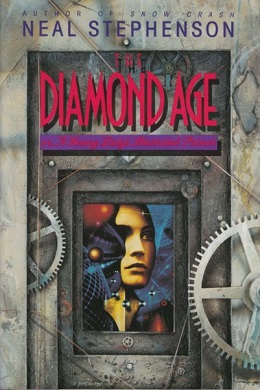
The Diamond Age: Or, A Young Lady's Illustrated Primer is a science fiction novel by American writer Neal Stephenson. It is to some extent a Bildungsroman or coming-of-age story, focused on a young girl named Nell, set in a future world in which nanotechnology affects all aspects of life. The novel deals with themes of education, social class, ethnicity, and the nature of artificial intelligence. The Diamond Age was first published in 1995 by Bantam Books, as a Bantam Spectra hardcover edition. In 1996, it won both the Hugo and Locus Awards, and was shortlisted for the Nebula and other awards.
Orion's Arm is a multi-authored online science fiction world-building project, first established in 2000 by M. Alan Kazlev, Donna Malcolm Hirsekorn, Bernd Helfert and Anders Sandberg and further co-authored by many people since. Anyone can contribute articles, stories, artwork, or music to the website. A large mailing list exists, in which members debate aspects of the world they are creating, discussing additions, modifications, issues arising, and work to be done.

Quantum dots (QDs) - also called semiconductor nanocrystals, are semiconductor particles a few nanometres in size, having optical and electronic properties that differ from those of larger particles as a result of quantum mechanics. They are a central topic in nanotechnology and materials science. When the quantum dots are illuminated by UV light, an electron in the quantum dot can be excited to a state of higher energy. In the case of a semiconducting quantum dot, this process corresponds to the transition of an electron from the valence band to the conductance band. The excited electron can drop back into the valence band releasing its energy as light. This light emission (photoluminescence) is illustrated in the figure on the right. The color of that light depends on the energy difference between the conductance band and the valence band, or the transition between discrete energy states when the band structure is no longer well-defined in QDs.

Power Rangers Time Force is a television series and the ninth season of the Power Rangers franchise, based on the 24th Super Sentai series Mirai Sentai Timeranger, running for 40 half-hour episodes from February to November 2001. It was the last season to be distributed by Saban Entertainment.
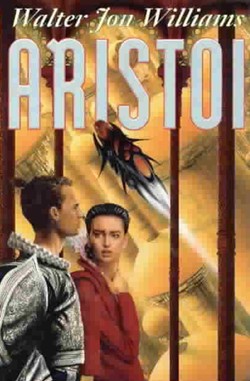
Aristoi is a 1992 science fiction novel by American writer Walter Jon Williams.
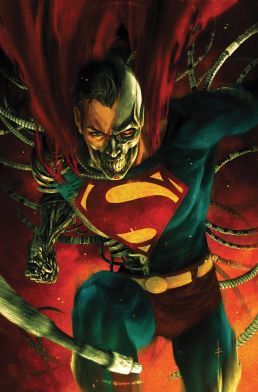
Henry "Hank" Henshaw is a supervillain appearing in American comic books published by DC Comics, and normally goes by the name Cyborg Superman. Created by writer-artist Dan Jurgens, the character originally appeared primarily as an enemy of Superman, however in recent years he has also been an enemy of the Green Lantern Corps.
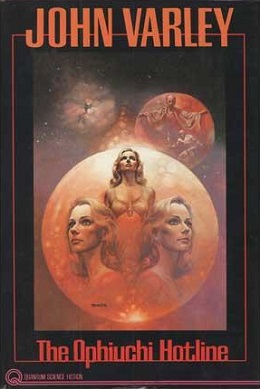
The Ophiuchi Hotline is a 1977 science fiction novel by American writer John Varley. It was nominated for a Locus Award. Part of his Eight Worlds series, the novel opens in the year 2618.
The use of nanotechnology in fiction has attracted scholarly attention. The first use of the distinguishing concepts of nanotechnology was "There's Plenty of Room at the Bottom", a talk given by physicist Richard Feynman in 1959. K. Eric Drexler's 1986 book Engines of Creation introduced the general public to the concept of nanotechnology. Since then, nanotechnology has been used frequently in a diverse range of fiction, often as a justification for unusual or far-fetched occurrences featured in speculative fiction.
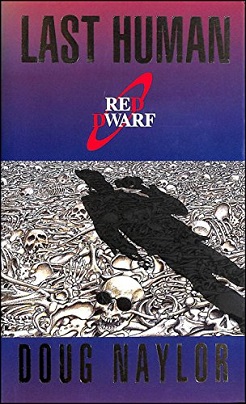
Last Human is the title of a 1995 science fiction comedy novel written by Doug Naylor. It is part of the Red Dwarf series of novels, based on the popular television show created by Naylor and his partner Rob Grant. Like the other novels, it does not take place within the television series continuity, but instead adapts situations presented on the series to occur within an alternative universe.
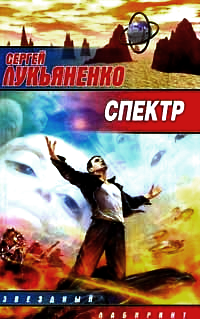
Spectrum is a science fiction novel by Russian writer Sergei Lukyanenko, taking place in the near future. Contact with aliens allowed humanity to travel between planets through portals. The Keymaster civilization not only provides new technologies to the world but also makes sure that their conditions are fulfilled to the letter: unrestricted access to the Gates for all who are willing. Payment for their use is an unusual story told to a Keymaster by the traveler. The main character of the novel is a private investigator who solves his clients' problems on other planets.
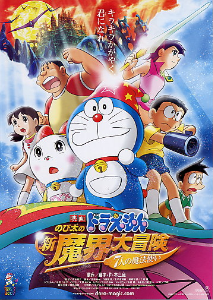
Doraemon: Nobita's New Great Adventure into the Underworld, also advertised as Doraemon the Movie 2007, is a 2007 Japanese animated science fantasy film. It is the 27th feature film of the Doraemon franchise. It is a retelling of the 1984 film Doraemon: Nobita's Great Adventure into the Underworld. It was the second highest grossing anime movie in 2007 after Pokémon: The Rise of Darkrai.
"Ghost Machine" is the third episode of the first series of the British science fiction television series Torchwood, which was broadcast on the digital television channel BBC Three on 29 October 2006.
Nanopunk refers to an emerging subgenre of science fiction that is still very much in its infancy in comparison to its ancestor-genre, cyberpunk, and some of its other derivatives.
This glossary of nanotechnology is a list of definitions of terms and concepts relevant to nanotechnology, its sub-disciplines, and related fields.

The DC Extended Universe (DCEU) is an American media franchise and shared universe centered on superhero films and other series starring various titular superheroes produced by DC Films / DC Studios, distributed by Warner Bros. Pictures, and based on characters that appear in American comic books published by DC Comics. Despite numerous film series in the past on characters such as Superman, Batman, and Green Lantern, none of those film series were connected. The DCEU debuted in 2013 with Man of Steel, centered on Superman, and has grown to include other characters such as Batman, Wonder Woman, and several others included in this list. The shared universe, much like the original DC Universe in comic books, was established by crossing over common plot elements, settings, cast, and characters, and will cross over with separate timelines from other DC-licensed film series in The Flash in order to create a "multiverse" before being largely rebooted as the new DC Universe franchise under new management from DC Studios.

Gamora is a fictional character portrayed primarily by Zoe Saldaña in the Marvel Cinematic Universe (MCU) media franchise, based on the Marvel Comics character of the same name. Gamora is depicted as a member of the Guardians of the Galaxy, having escaped her previous life as an assassin after she was forcibly adopted by Thanos after he murdered half of her people, including her mother. For the next twenty years, she served Thanos as a cybernetically enhanced warrior until betraying him to join the Guardians. Over time she becomes romantically involved with Peter Quill, and develops a positive relationship with her adopted sister Nebula despite their rivalrous upbringing. She is eventually killed by Thanos when he sacrifices her to obtain the Soul Stone.












